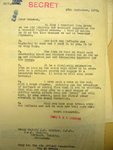Glider
Captain
I don't know the action being discussed but do know that the plan was for the Defiant to start above the Bomber, dive underneath it, get to the blind spot below and to one side before firing away. While this is happening the bombers top and bottom guns will have the chance to fire first, the bomber will of course stay straight and level and the defending fighters ignore this sitting defenceless duck which is trying to shoot down the bombers.
I have a feeling that even Downing had his doubts, see item 4 in the letter
PS this is the whole letter, the total letter, with nothing added, taken away, modified and/or changed.
I have a feeling that even Downing had his doubts, see item 4 in the letter
PS this is the whole letter, the total letter, with nothing added, taken away, modified and/or changed.

